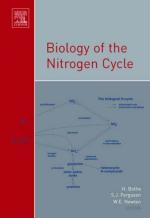|
This section contains 659 words (approx. 3 pages at 300 words per page) |

|
All life is dependent on nitrogen; nitrogen is a critical component of amino acids, protein, DNA, and RNA. While the atmosphere is 78 percent nitrogen, animals and plants cannot convert nitrogen directly from the atmosphere into a utilizable form. The nitrogen cycle is the process by which nitrogen from the atmosphere is converted to biological nitrogen compounds in plants and animals and then is returned to the atmosphere. The major steps in the nitrogen cycle are nitrogen fixation, nitrification, nitrogen assimilation, denitrification, and ammonification.
Nitrogen fixation is the conversion of nitrogen (N2) in the atmosphere to nitrates (NO3-) and ammonia (NH3). In nature, this is done primarily by microorganisms (bacteria and algae). The most important bacteria in this process are symbiotic bacteria that live on nodules on the roots of leguminous plants such as soybeans, peas, and alfalfa. The electricity in lightning also can cause a...
|
This section contains 659 words (approx. 3 pages at 300 words per page) |

|


